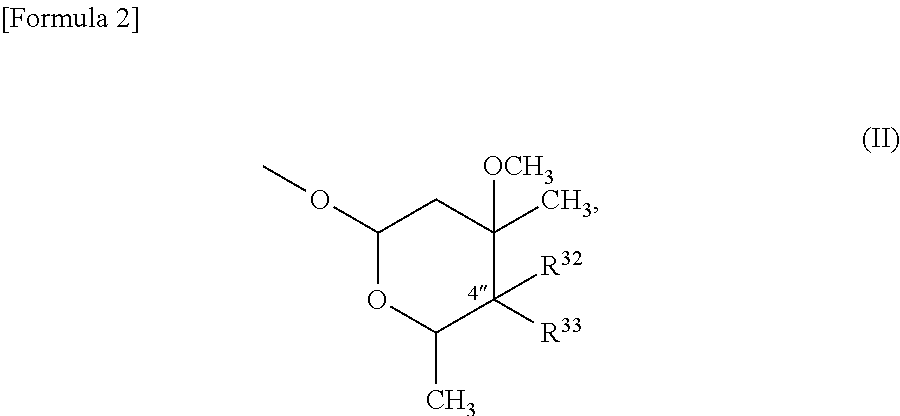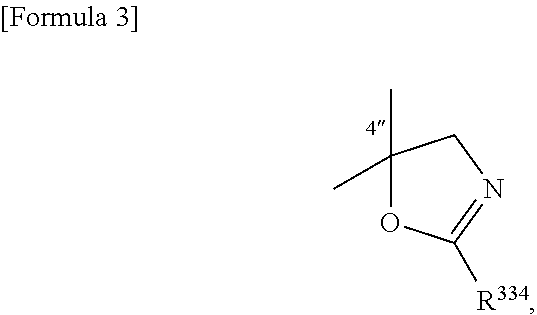10a-azalide compound having 4-membered ring structure
a technology of azalide and compound, which is applied in the direction of antibacterial agents, drug compositions, extracellular fluid disorder, etc., can solve the problems of inconstant pharmacokinetics of erythromycin, and achieve the effect of superior antibacterial activity
- Summary
- Abstract
- Description
- Claims
- Application Information
AI Technical Summary
Benefits of technology
Problems solved by technology
Method used
Image
Examples
reference example 1
Synthesis of Compound of the Formula (A) Wherein R is Methyl Group
[0336](1) (9S)-9-Dihydro-6-O-methylerythromycin A (84.5 g, 112.7 mmol) obtained by the method described in the literature (The Journal of Antibiotics, 1990, vol. 43, 10, p. 1334) and imidazole (80.6 g, 1183 mmol) were dissolved in dimethylformamide (1000 ml), the solution was cooled to 0° C., and triethylsilyl chloride (59.4 g, 394.4 mmol) was added dropwise to the solution. After the addition, the mixture was stirred at room temperature for 16 hours, then ethyl acetate (500 ml), hexane (500 ml), and distilled water (1000 ml) were added to the mixture, and the layers were separated. The organic layer was washed successively with saturated aqueous ammonium chloride (300 ml) and saturated brine, and dried over anhydrous magnesium sulfate, and then the solvent was evaporated under reduced pressure. The resulting residue was purified by silica gel column chromatography (hexane:ethyl acetate=100:1 to 5:1) to obtain a prote...
reference example 2
Synthesis of Compound of the Formula (A) Wherein R is Hydrogen Atom
[0339](1) Erythromycin A (10.0 g, 13.6 mmol) was dissolved in methanol (30 ml), the solution was cooled to 0° C., sodium borohydride (2.58 g, 68.1 mmol) was added to the solution, and the resulting mixture was stirred for 1 hour. Ethyl acetate (150 ml), distilled water (50 ml), and saturated brine (150 ml) were added to the reaction mixture, and the layers were separated. The organic layer was dried over anhydrous magnesium sulfate, and filtered, then the filtrate was cooled to 0° C., and a solution obtained by diluting a 4 N solution of hydrochloric acid in ethyl acetate (3.5 ml) with ethyl acetate (30 ml) was added dropwise to the filtrate with stirring. The resulting mixture was stirred at room temperature for 15 hours, and then the deposited solid was collected by filtration, and washed with ethyl acetate. The resulting solid was suspended in ethyl acetate (200 ml), sodium carbonate (1.18 g) and distilled water (...
reference example 3
Synthesis of N-ethyl-N-[(1S)-1-(2-methoxyphenyl)ethyl]ethane-1,2-diamine
[0342](1) (1S)-1-(2-Methoxyphenyl)ethylamine (8.86 g) obtained by the method described in the publication (Japanese Patent Unexamined Publication No. 54 / 154724) was dissolved in chloroform (100 ml), acetic anhydride (12.0 g) and 4-dimethylaminopyridine (14.3 g) were added to the solution, and the mixture was stirred at 70° C. for 30 minutes. The reaction mixture was left to cool, and then washed successively with 1 N hydrochloric acid, and 10% aqueous sodium hydroxide. The organic layer was dried over anhydrous magnesium sulfate, and filtered, and then the filtrate was concentrated under reduced pressure to obtain an acetyl compound (11.23 g).
(2) Lithium aluminum hydride (3.3 g) was suspended in tetrahydrofuran (200 ml), and the compound obtained in (1) mentioned above (11.2 g) was added to the suspension over 15 minutes under reflux by heating. The reaction mixture was stirred for 3 hours under reflux by heatin...
PUM
 Login to view more
Login to view more Abstract
Description
Claims
Application Information
 Login to view more
Login to view more - R&D Engineer
- R&D Manager
- IP Professional
- Industry Leading Data Capabilities
- Powerful AI technology
- Patent DNA Extraction
Browse by: Latest US Patents, China's latest patents, Technical Efficacy Thesaurus, Application Domain, Technology Topic.
© 2024 PatSnap. All rights reserved.Legal|Privacy policy|Modern Slavery Act Transparency Statement|Sitemap



